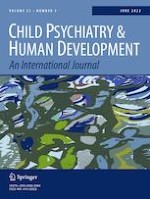15-02-2021 | Original Article
A Multi-level Longitudinal Model of Risk Factors for Generalized and Separation Anxiety Symptoms in a Community Sample of 6-year-olds
Gepubliceerd in: Child Psychiatry & Human Development | Uitgave 3/2022
Log in om toegang te krijgenAbstract
The current longitudinal study examined the relations between variables in four domains—contextual (SES, family conflict, stress), parent (caretaker depression), parenting (support hostility, autonomy granting), and child (negative affect, effortful control, sensory regulation, attachment)—and both the presence of generalized and separation anxiety symptoms at age 6 in a community sample of 796 children and the change in these anxiety symptoms from ages 4 to 6. Anxiety was highly stable over time. Specific results revealed both direct and indirect pathways between age 4 and age 5 variables, and age 6 anxiety. Caretaker depression and the child variables of attachment, effortful control, negative affect, and sensory regulation were directly related to anxiety symptoms at age 6. Contextual variables (SES) at age 4 were indirectly related to age 6 anxiety through parent depression at age 5. Parent depression was indirectly related to age 6 anxiety through age 5 child negative affect. Child negative affect at age 4 was indirectly related to age 6 anxiety through age 5 effortful control and age 4 effortful control was indirectly related to age 6 anxiety through age 5 negative affect. With the exception of attachment, there was a reduction in the impact of other variables when initial levels of anxiety symptoms were included in the model. Implications of results for early intervention and further study are discussed.
